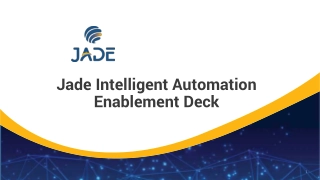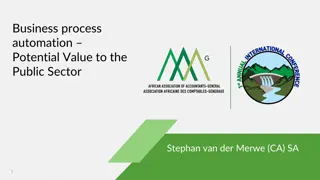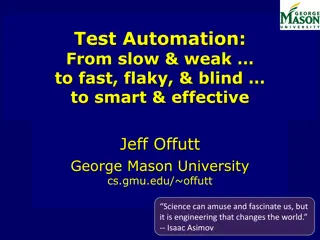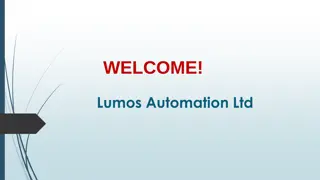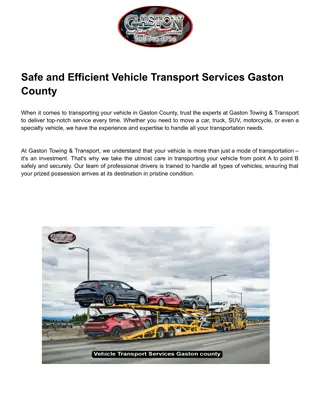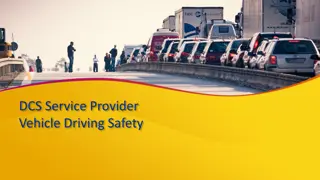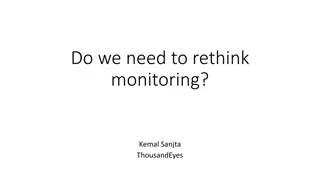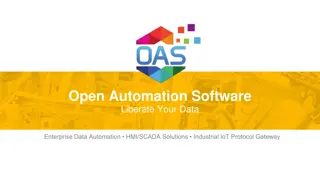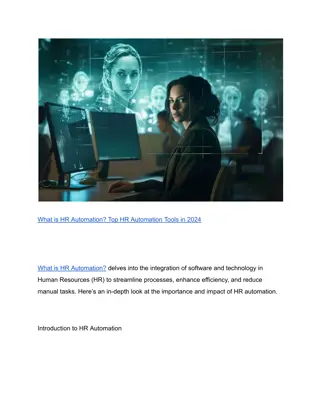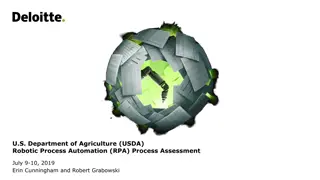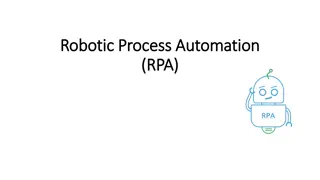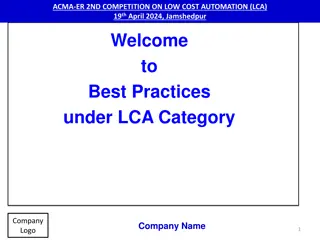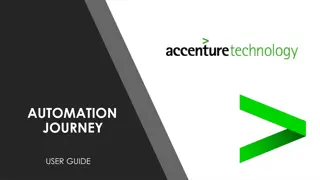Different Systems in Vehicle Automation
Two different systems are discussed, one in the core text and one in Annex 4, related to the driving function and technical/electronic aspects of automated driving functions. Consistency needs to be established without unnecessary duplications, with mentions of HMI and OEDR. The audit process needs to include physical verification along with simulations and testing to confirm findings. Annex 4 involves analysis and potential testing based on audit results.
Download Presentation

Please find below an Image/Link to download the presentation.
The content on the website is provided AS IS for your information and personal use only. It may not be sold, licensed, or shared on other websites without obtaining consent from the author.If you encounter any issues during the download, it is possible that the publisher has removed the file from their server.
You are allowed to download the files provided on this website for personal or commercial use, subject to the condition that they are used lawfully. All files are the property of their respective owners.
The content on the website is provided AS IS for your information and personal use only. It may not be sold, licensed, or shared on other websites without obtaining consent from the author.
E N D
Presentation Transcript
Informal document GRVA-07-07 7th GRVA session, 21-25 September 2020 Agenda item 4(d) Transmitted by the expert from the Russian Federation
In our understanding we are talking about two different kind of systems: 1. in core text: system is used more generally as term to describe the driving function (which controls the lateral and longitudinal movement of the vehicle) 2. in Annex 4: system purely has a technical/electronical meaning system in core text translates into automated driving function in Annex 4 AL: This is the same system in my view (but including the link with other systems). This is a major change compared to old Annex 6 to R79 FR : from our point of view, both definitions are compatible and consistent.
Definitely agree in principle that consistency needs to be established (and at the same time avoid unnecessary duplications) AL: In my view the cross reference from the core text to Annex 4 is sufficient+ para 3,1, (b) of Annex 4.So no need to make reference from the Annex to the core text again. HMI and OEDR were last minute comments in VMAD. I will double if they are needed FR : from our point of view, consistency is preserved by the mention in all core text pargraphs.
Can confirm this is also our current understanding. (Although generally, in the future, simulation could also be part of type approval assessment, meaning simulations are conducted by the Approval Authority or Technical Service) AL: The audit cannot only be paper based, but has to include physical verification (like today in Annex 6 of R79). Of course we shall take into account tests carried out under Annex 5 (which can be used as part of the verification of the audit), but authorities may for instance ask the manufacturer to test a vehicle outside the conditions defined in Annex 5. In my view simulation from the manufacturer can be used to confirm the findings of the audit as well (but cannot replace the test in Annex 5) FR : Annex 4 is in a first step based on an OEM documentation/justification analysis. Depending on the results of this analysis, TAA/TS may require tests in order to check specific points discussed during the audit evaluation. These tests can be based on scenarios listed in annex 5 with specific test parameters (annex 5 opened in this way) or/and on additional scenarios not covered by annex 5. All tests from annex 5 have to be finally performed during approval process, requested following annex 4 audit or not.
DE: Appendix 2 (of Annex 4) is part of the Communication form (Annex 1) and gives more detailed information about ALKS. AL: Check ECE/TRANS/WP29/2020/81. What is communicated to other authorities is an extract of Appendix2 (high level description) 3.4.4. are documentary check on the safety argumentations. Para 4 are physical/simulation tests to confirm the documentation. Some physical checks are mandatory in Annex 5. Simulation is not mandatory, but can be used (not as an alternative to physical test in Annex 5) FR : we agree that the word other in 6. shall be removed, bringing confusion and support EC positions on understanding of 3.4.4.
DE: We now share your understanding and can therefore agree to your proposal. Actually, to explain our reading before: we thought this aspect you now add ( this shall be demonstrated in the assessment carried out under Annex 4 ) was already covered by para. 5.1 -- even though now that you point it out, you are for sure right, the intention in para. 5.2.5. should not be to limit an assessment to Appendix 3 only. Therefore we can support your amendment. JPN: Appendix3 is the validation method of the requirement in paragraph 5.2.5 (the level at which a competent and careful human driver could minimize the risks) and in order to clearly show the linkage between the requirement and its validation method, the appendix should be directly linked to the same paragraph as the requirement. The importance of clearly indicating the relationship between them by putting in the same paragraph the requirement and the link to the corresponding appendix was first proposed by the chair of GRVA and supported by EC at the 5th GRVA, and the text was drafted accordingly and agreed at the 6th GRVA. Therefore we do not support your suggested amendment. EC: the idea with Appendix 3 was to define the critical scenarios in the most comprehensive manner. This fits better with the core text, (5.2.5)
DE: We understand your questions and hope our colleagues from Japan can help with explanations to clarify! Generally, in our view any Annex or Appendix and this Appendix in particular since it introduces a new model should: - enable other CPs to add/contribute with own national data - be transparent in how the models are valid for other (national) traffic conditions and can be transferred/applied to them - give/enable flexibility to evolve as the automated driving systems will develop over time as well JPN: First of all, we would like to point out that Appendix3 is describing scenarios which was considered in SG1a whereas simulation was considered in SG2a and is provided in Annex4. Generally speaking, Appendix3 provides sufficient coverage of patterns of scenarios under which ALKS shall not cause any collision, which have not been realized by the previous approach. These concepts are considered based on "reasonably foreseeable" and "reasonably preventable " principle provided in the Framework Document. Without Appendix3, the boundary of scenarios under which collisions should be prevented and under which collisions can be regarded as unpreventable is ambiguous ( please see GRVA-05-62e). Since Appendix3 is a guidance in this regulation, it is not mandatory from the regulatory point of view but SG1a thinks that at least three types of many scenarios are necessary for the assessment of ALKS. As for the questions regarding simulation, although SG2a may be in a better position to answer those questions, our understanding is that technical services can (not "shall") use Appendix 3 when assessing ALKS by doing multi-pillars including simulation, that the technical services shall ensure through such assessment that no collision is caused in the green field of the pictures, and that it is important to have a flexibility what the technical services should do (therefore, Annex 4 doesn t specify who perform what kind of tests and simulation. According to Annex 4, those should be decided by technical services and if so required by them, manufactures have to prepare simulation software.
DE: Understood what you are aiming at, but we should be careful that an amendment in Annex 4 does not read like a requirement itself. JPN: The conclusion of the discussion of ALKS is not writing this kind of text and considers Appendix3 as a guidance. EC: Is this not already covered by the core text (5.2.5)?
DE: Our understanding is that all tests in Annex 5 are conducted by a Technical Service themselves (not just witnessed). EC: This is also our understanding/ But I agree that this section is misleadling and we need to discuss how it interact with Annex 4 FR : it was also our initial understanding but could be more clearly specified especially since annex 4 mention that TAA shall perform or require performing
DE: Just to make sure: we understand the - to read as a bullet point, not a minus. Correct? Yes, this summary seems to give the full picture. We are just wondering about the Technical Service s Simulation results : where is this required in the ALKS Regulation? (Are we missing something ?) Isn t simulation just part of the audit? EC: I agree with Russia. We should define which items should be tested as a minimum. This requires more discussion FR : this scheme is really understandable by TAA/TS, could be added in the Regulation ? Just some comments : - Box 1 : simulation is not mandatory but optional - Box 2 : not a dedicated box but an evaluation under box 1 if simulations are provided



